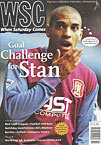 A new report has been published that analyses the impact of black footballers. Ashley Shaw studies the results
A new report has been published that analyses the impact of black footballers. Ashley Shaw studies the results
While racism may have largely disappeared from our football grounds, as a recent survey demonstrates the English game is not quite the prejudice-free utopia the FA would have us believe. According to Steven Szymanski, author of Beaten in the Race for the Bell, an economic divide still exists between white and black players in English football.
Szymanski’s research compared the wage bills of teams of similar League position between 1974 and 1993. Taking into account the importance of black players to a club (judging by the number of appearances in a season and their position in a team) the conclusion is that white players earn more on average for being less successful and less productive.
Szymanski goes on to claim that black players tend to be more successful than whites, and as a result there is a greater concentration of blacks at the top end of the League. He maintains that economic discrimination, in the shape of lower wages for more work, characterises English football as much as the long ball or the Cup run. Just because a few black players have enjoyed successful careers and earned big salaries does not mean that black and white take the field on an equal footing. Perhaps more importantly this type of discrimination at the higher levels of the game has a knock-on effect on black youngsters trying to make their way further down the League.
If managers prefer to employ white players, rather than their equally skilled black counterparts, then young black players of lesser ability will find it ever harder to break into the lower reaches of professional football. Szymanski also underlines the difficulties faced by black players in the North. His research discovered that although Northern clubs tended to be based near large ethnic populations, they were less likely to have black players in the team compared to clubs in the Midlands and London. Part of this is explained by the conclusion that areas such as Toxteth or Moss Side are subject to a higher degree of social segregation than Brixton or Handsworth.
For example the 20,000 or so mainly white supporters who descended on Maine Road ever two weeks are more likely to live in the suburbs rather than in the area – in short, they wouldn’t dream of going there other than to watch a first team game. As a consequence the surrounding black population feel little connection with the club on their doorstep, an alienation which manifests itself within the first team at the club – dominated by whites and foreigners, with little prospect of a local lad making good. Community programmes may have helped to improve the relationship between the local populace and the football club but the progress made here has more than likely been outweighed by the increased propensity of football managers to sign foreign players. In addition schools of excellence, originally established to ensure that a club had a smattering of local talent on its books, are just as likely to recruit from the suburbs as their immediate areas.
And as competition for places at schools of excellence intensifies, additional demands are being made of potential footballers. No longer is footballing skill the sole criterion when it comes to securing a place as an apprentice, clubs’ are just as likely to look at the standards of an individual’s education. As social surveys in the past have concluded, black teenagers tend to attend schools with lower academic standards because of the areas they live in. Here again black youngsters look set to lose out.
It is strange that there should be barely a whisper about this report in the press when you consider the thousands of words devoted to Ian Wright’s mental state in the tabloids. After the infamous bust-up with Peter Schmeichel, it took several days before it was revealed that Wright had been racially abused. In the meantime Wright was almost unanimously assumed to be the guilty party. Ian Wright is a controversial figure, a target for abuse and praise in almost equal measure, but for the black community he represents something more, a player from their neck of the woods who has been successful without bowing to white authority. It is little wonder that Arsenal have the highest number of black season ticket holders in the country.
Wright did not turn professional until his mid-20s, an age at which most footballers are reaching their peak. In his case he was fortunate that he started his League career at a time when foreign players were rare and the value of black players was rising. Today the reverse seems to be the case, with potential Ian Wrights competing with Norwegians and Australians for a first team place.
The anti-racism campaigns initiated by football supporters and belatedly taken up by the FA have done much to eliminate the kind of racism which greeted the arrival of John Barnes at Liverpool. But there is still a colour bar in place when it comes to black players occupying decision-making positions: white players are still more likely to go into club management, to be named club captain or appointed player-coach. While clubs discriminate against their own black players they are in no position to complain when a moronic section of their crowd behave the same way. Most League clubs have made a public show of backing the various Kick Racism out of Football initiatives but their commitment to such campaigns has to be questioned when, as Steven Szymanski’s report underlines, they are still continue to deny equal pay for equal work.
From WSC 132 February 1998. What was happening this month